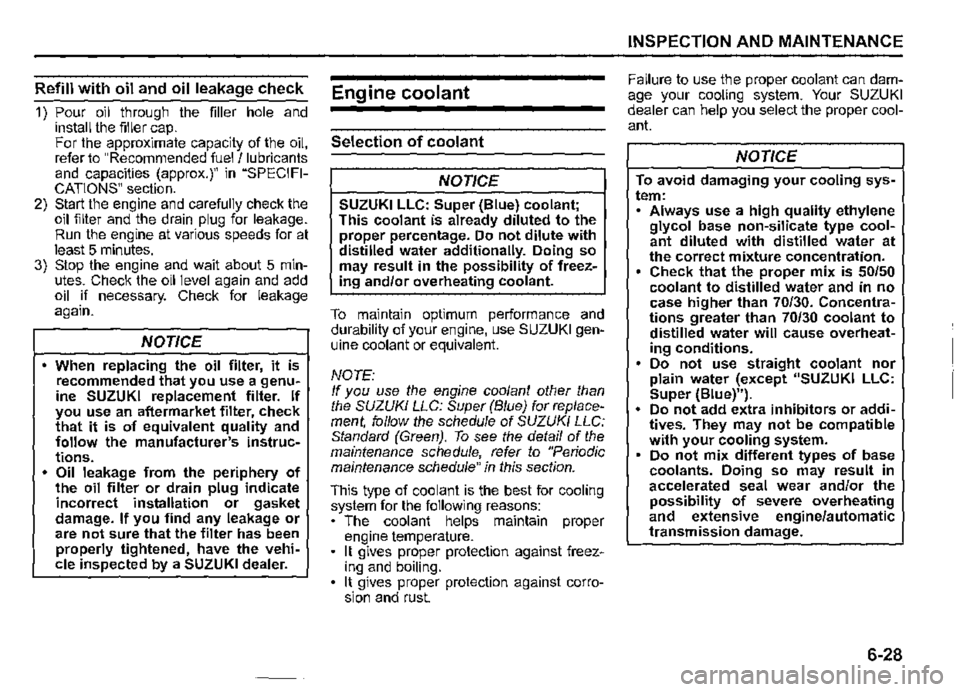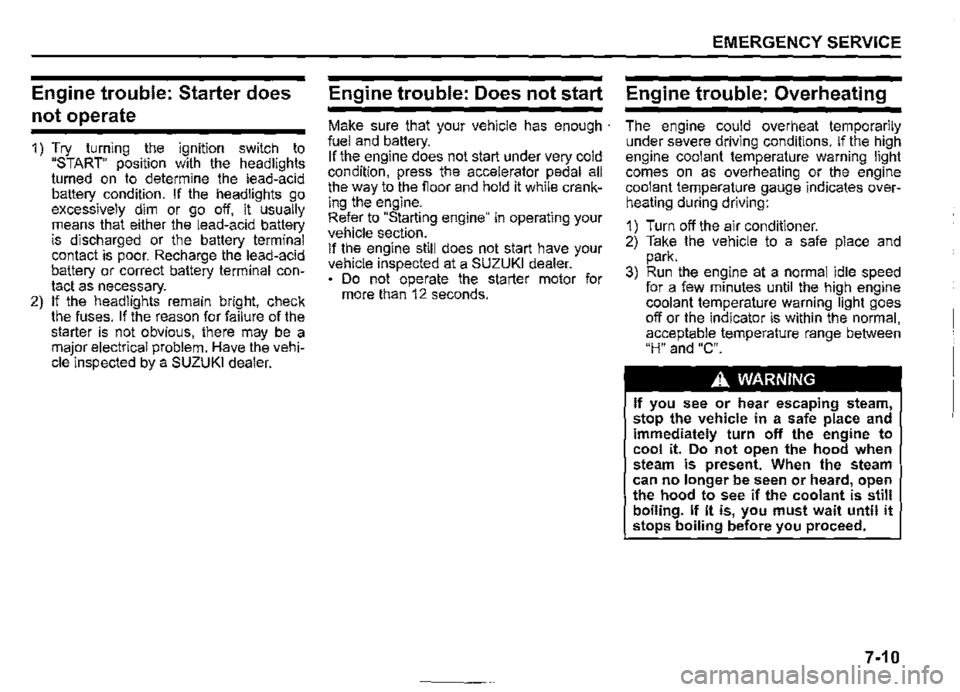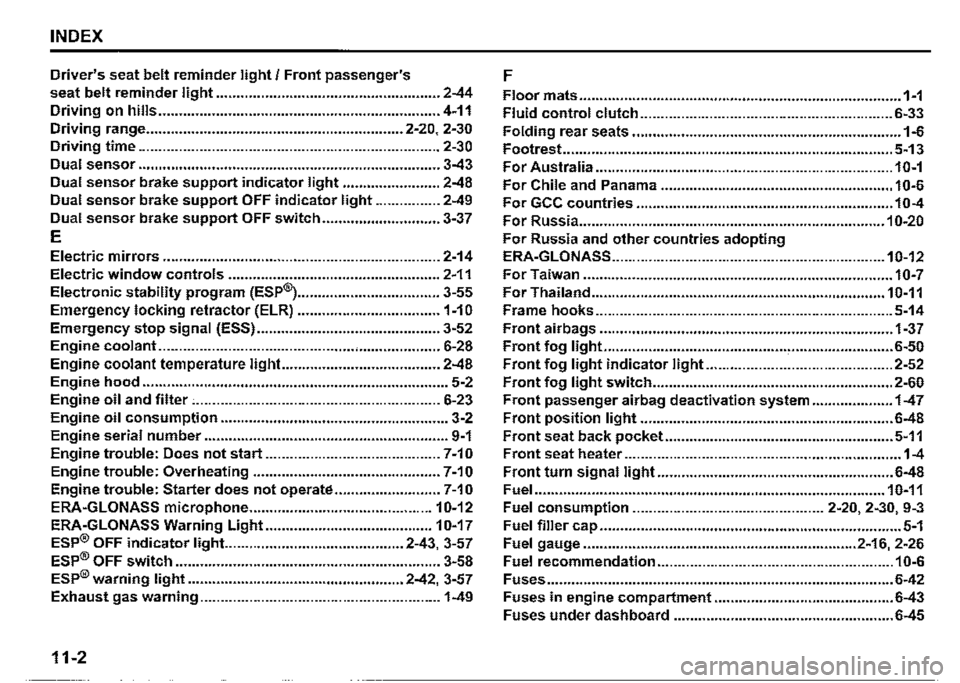stop start SUZUKI JIMNY 2020 Owner's Guide
[x] Cancel search | Manufacturer: SUZUKI, Model Year: 2020, Model line: JIMNY, Model: SUZUKI JIMNY 2020Pages: 421, PDF Size: 6.35 MB
Page 342 of 421

INSPECTION AND MAINTENANCE
It is important to keep the engine oil at the correct level for proper lubrication of your vehicle's engine. Check the oil level with the vehicle on a level surface. The oil level indication may be inaccurate if the vehicle is on a slope. The oil level should be checked either before starting the engine or at least 5 minutes after stopping the
engine. The handle of the engine oil dipstick is colored with yellow for easy identification.
6-25
Pull out the oil dipstick, wipe the oil off with a clean cloth, insert the dipstick all the way into the engine, and then remove it again. The oil on the stick should be between the upper and lower limits shown on the stick. If the oil level indication is near the lower, limit, add enough oil to raise the level to the upper limit.
NOTICE
Failure to check the oil level regularly could lead to serious engine trouble due to insufficient oil.
Refilling
Open Close tr-------~,
• \lc----------,1/.
52RM60020
Remove the oil filler cap and pour oil slowly through the filler hole to bring the oil level to the upper limit on the dipstick. Be careful not to overfill the oil. Too much oil is almost as bad as too little oil. After refilling, start the engine and allow it to idle for about a minute. Stop the engine, wait about 5 minutes and check the oil level again.
Page 345 of 421

Refill with oil and oil leakage check
1) Pour oil through the filler hole and install the filler cap. For the approximate capacity of the oil, refer to "Recommended fuel / lubricants and capacities (approx.)" in "SPECIFICATIONS" section. 2) Start the engine and carefully check the oil filter and the drain plug for leakage. Run the engine at various speeds for at least 5 minutes. 3) Stop the engine and wait about 5 minutes. Check the oil level again and add oil if necessary. Check for leakage again.
NOTICE
When replacing the oil filter, it is recommended that you use a genuine SUZUKI replacement filter. If you use an aftermarket filter, check that it is of equivalent quality and follow the manufacturer's instructions. • Oil leakage from the periphery of the oil filter or drain plug indicate incorrect installation or gasket damage. If you find any leakage or are not sure that the filter has been properly tightened, have the vehicle inspected by a SUZUKI dealer.
Engine coolant
Selection of coolant
NOTICE
SUZUKI LLC: Super (Blue) coolant; This coolant is already diluted to the proper percentage. Do not dilute with distilled water additionally. Doing so may result in the possibility of freezing and/or overheating coolant.
To maintain optimum performance and durability of your engine, use SUZUKI genuine coolant or equivalent.
NOTE: If you use the engine coolant other than the SUZUKI LLC: Super (Blue) for replacement, follow the schedule of SUZUKI LLC: Standard (Green). To see the detail of the maintenance schedule, refer to "Periodic maintenance schedule" in this section.
This type of coolant is the best for cooling system for the following reasons: • The coolant helps maintain proper engine temperature. It gives proper protection against freezing and boiling. It gives proper protection against corrosion and rust.
INSPECTION AND MAINTENANCE
Failure to use the proper coolant can damage your cooling system. Your SUZUKI dealer can help you select the proper coolant.
NOTICE
To avoid damaging your cooling system: Always use a high quality ethylene glycol base non-silicate type coolant diluted with distilled water at the correct mixture concentration. Check that the proper mix is 50/50 coolant to distilled water and in no case higher than 70/30. Concentrations greater than 70/30 coolant to distilled water will cause overheating conditions. Do not use straight coolant nor plain water (except "SUZUKI LLC: Super {Blue)"). . • Do not add extra inhibitors or additives. They may not be compatible with your cooling system. Do not mix different types of base coolants. Doing so may result in accelerated seal wear and/or the possibility of severe overheating and extensive engine/automatic transmission damage.
6-28
Page 386 of 421

EMERGENCY SERVICE
Rear wheels lifted (all models)
"ON"__.. "ACC"
UNLOCKED
78RB08006
7-9
Rear wheels lifted Your vehicle may be towed by a tow truck with the rear wheels lifted and the front wheels on the ground. Towing speed should not exceed 90 km/h (55 mph).
For this type of towing: 1) Shift the manual transmission to Neutral or the automatic transmission to "P" position and start the. engine. 2) Shift the transfer lever to 2WD position ("2H"). 3) Make sure the 4WD indicator on the instrument cluster is turned off.
NOTICE
If the air-locking hubs cannot be unlocked, tow the vehicle with the rear wheels lifted and a dolly under the front wheels.
4) Turn the ignition key to the "ACC" position to stop the engine and to unlock the steering wheel.
NOTICE
The steering column lock is not strong enough to withstand shocks transmitted from the front wheels during towing.
5) Make sure the front wheels are facing straight forward and secure the steering wheel with a steering wheel clamping device designed for towing service.
Page 387 of 421

Engine trouble: Starter does
not operate
1) Try turning the ignition switch to "START" position with the headlights turned on to determine the lead-acid battery condition. If the headlights go excessively dim or go off, it usually means that either the lead-acid battery is discharged or the battery terminal contact is poor. Recharge the lead-acid battery or correct battery terminal contact as necessary. 2) If the headlights remain bright, check the fuses. If the reason for failure of the starter is not obvious, there may be a major electrical problem. Have the vehicle inspected by a SUZUKI dealer.
Engine trouble: Does not start
Make sure that your vehicle has enough · fuel and battery. If the engine does not start under very cold condition, press the accelerator pedal all the way to the fioor and hold it while cranking the engine. Refer to "Starting engine" in operating your vehicle section. If the engine still does not start have your vehicle inspected at a SUZUKI dealer. Do not operate the starter motor for more than 12 seconds.
EMERGENCY SERVICE
Engine trouble: Overheating
The engine could overheat temporarily under severe driving conditions. If the high engine coolant temperature warning light comes on as overheating or the engine coolant temperature gauge indicates overheating during driving:
1) Turn off the air conditioner. 2) Take the vehicle to a safe place and park. 3) Run the engine at a normal idle speed for a few minutes until the high engine coolant temperature warning light goes off or the indicator is within the normal, acceptable temperature range between "H" and "C".
A WARNING
If you see or hear escaping steam, stop the vehicle in a safe place and immediately turn off the engine to cool it. Do not open the hood when steam is present. When the steam can no longer be seen or heard, open the hood to see if the coolant is still boiling. If it is, you must wait until it stops boiling before you proceed.
7-10
Page 412 of 421

INDEX
Driver's seat belt reminder light/ Front passenger's F seat belt reminder light ....................................................... 2-44 Floor mats ............................................................................... 1-1 Driving on hills ..................................................................... 4-11 Fluid control clutch .............................................................. 6-33 Driving range ............................................................... 2-20, 2-30 Folding rear seats .................................................................. 1-6 Driving time .......................................................................... 2-30 Footrest ................................................................................. 5-13 Dual sensor .......................................................................... 3-43 For Australia ......................................................................... 10-1 Dual sensor brake support indicator light ........................ 2-48 For Chile and Panama ......................................................... 10-6 Dual sensor brake support OFF indicator light ................ 2-49 For GCC countries ............................................................... 10-4 Dual sensor brake support OFF switch ............................. 3-37 For Russia ........................................................................... 10-20
E For Russia and other countries adopting
Electric mirrors .................................................................... 2-14 ERA-GLONASS ................................................................... 10-12
Electric window controls .................................................... 2-11 For Taiwan ............................................................................ 10-7
Electronic stability program (ESP®) ................................... 3-55 For Thailand ........................................................................ 10-11
Emergency locking retractor (ELR) ..................................• 1-1 O Frame hooks ......................................................................... 5-14
Emergency stop signal (ESS) ............................................. 3-52 Front airbags ........................................................................ 1-37
Engine coolant ..................................................................... 6-28 Front fog light ............................................. , ......................... 6-50
Engine coolant temperature light ....................................... 2-48 Front fog light indicator light .............................................. 2-52
Engine hood ........................................................................... 5-2 Front fog light switch ........................................................... 2-60
Engine oil and filter , ............................................................ 6-23 Front passenger airbag deactivation system .................... 1-47
Engine oil consumption ........................................................ 3-2 Front position light .............................................................. 6-48
Engine serial number ............................................................ 9-1 Front seat back pocket ........................................................ 5-11
Engine trouble: Does not start ........................................... 7-10 Front seat heater .................................................................... 1-4
Engine trouble: Overheating .............................................. 7-1 O Front turn signal light .......................................................... 6-48
Engine trouble: Starter does not operate .......................... 7-10 Fuel ...................................................................................... 10-11
ERA-GLONASS microphone ............................................. 10-12 Fuel consumption ............................................... 2-20, 2-30, 9-3
ERA-GLONASS Warning Light ......................................... 10-17
ESP® OFF indicator light. ........................................... 2-43, 3-57
ESP® OFF switch ................................................................. 3-58
Fuel filler cap .......................................................................... 5-1
Fuel gauge ................................................................... 2-16, 2-26
Fuel recommendation .......................................................... 10-6
ESP® warning light ..................................................... 2-42, 3-57 Fuses ..................................................................................... 6-42
Exhaust gas warning ........................................................... 1-49 Fuses in engine compartment ............................................ 6-43
Fuses under dashboard ...................................................... 6-45
11-2